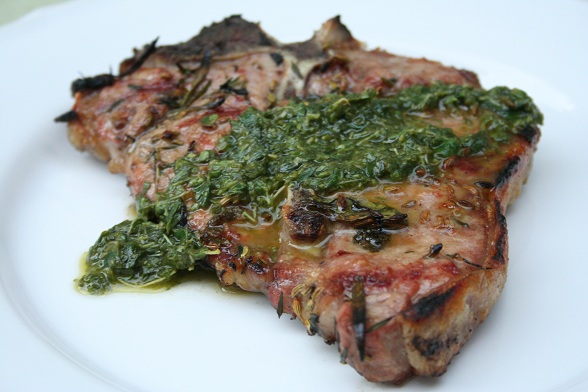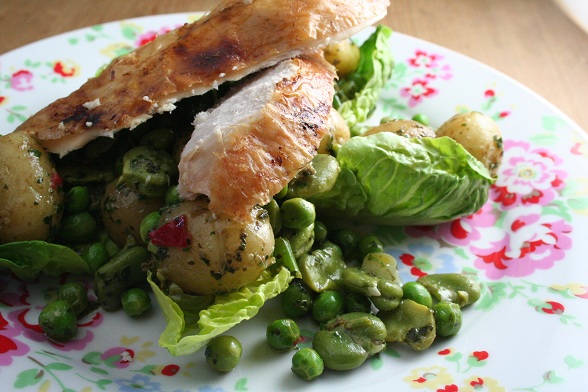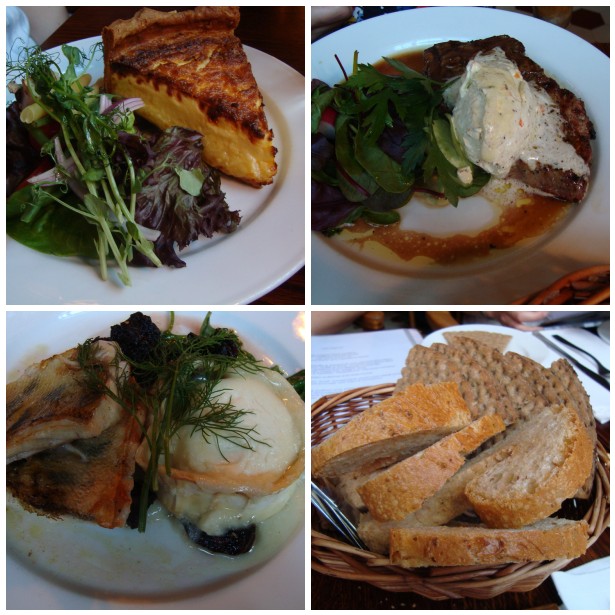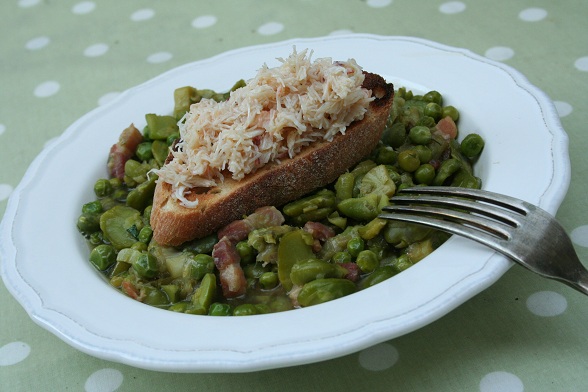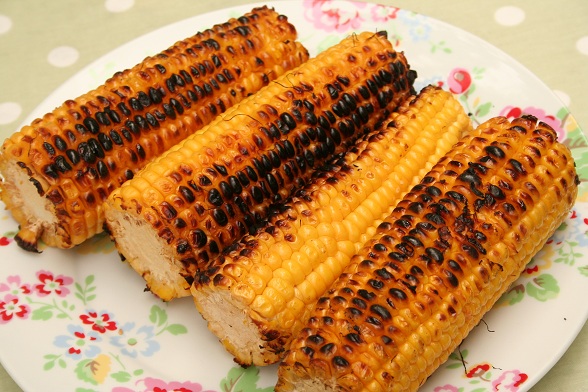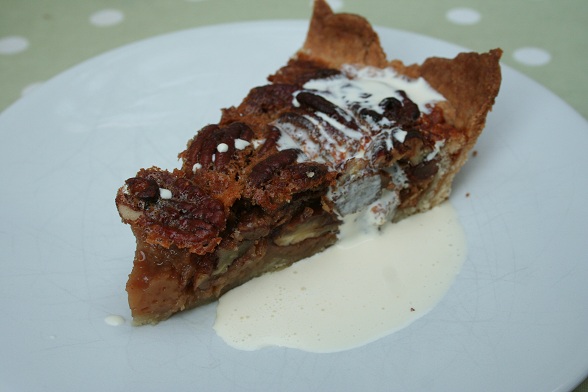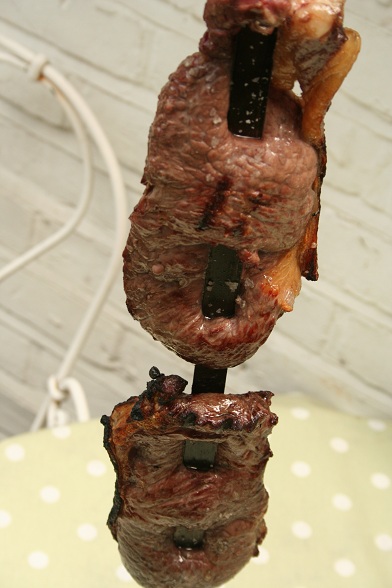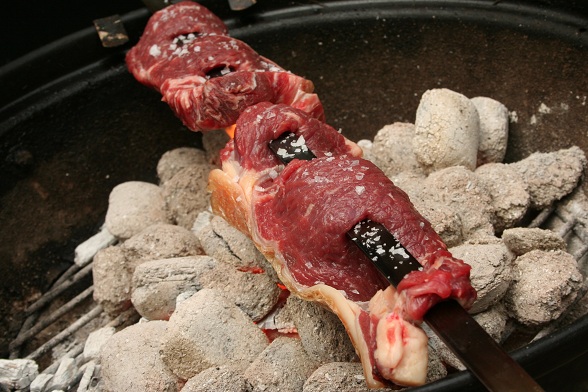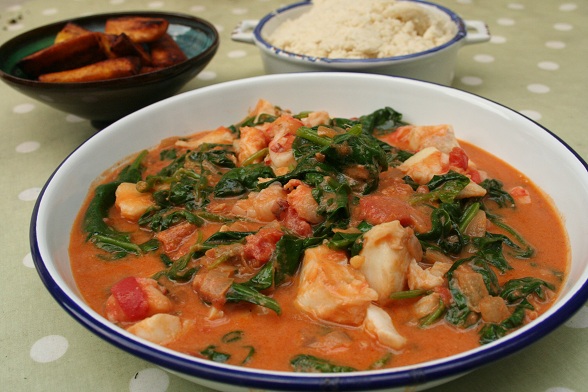Barbecued Rose Veal with Salmoriglio
We haven’t done nearly enough barbecuing this year so, as we had a little more time than normal tonight, Stephen rolled out the Weber and got busy with some veal chops.
While we were away our herbs flourished and we’re now more than a little over-run with tasty, green stuff. This Valentine Warner recipe was ideal for our predicament and also used rose veal which we both like but don’t eat nearly enough of. Stephen was able to find some locally and get it marinading for a decent amount of time which, combined with the herby-dressing, led to some really tasty meat. It was cheap too, around £7 for two large chops which, had they been beef would have probably been twice that.



Smoked Salmon with Dill Potatoes and Summer Vegetables
When I thought this up this morning, I was quite pleased with myself. It used up some fridge-bottom ingredients, was fairly quick, used seasonal vegetables with an interesting dressing to bring it all together. Stephen has just pointed out that actually, it’s just a variation on Tuesday’s dinner and, like everything else we’ve eaten this week, features something plonked on top of something else.
None of that really matters if it tastes good though and, luckily for us, this did. The potatoes were boiled with some dill and added to the briefly-cooked peas and asparagus before being tossed with a honey and mustard dressing. The salmon was then plonked on top.
The dressing did work as I thought it would and brought the whole lot together but the asparagus (not part of the original plan) was the real star. Of course, it’s a traditional pairing for smoked salmon but the sweetness of the honey really brought out the grassiness of the asparagus.
We don’t currently have any plans for tomorrow night’s dinner but perhaps I’ll try to think of a different way to present it, even if it does turn out to be just another something on top of something else.



Halloumi with Barley Cous Cous
Back to work today and with nothing planned for dinner, we improvised with some halloumi and some barley cous-cous that’s been hanging around in the cupboard for a while. We were both too tired to really think this through properly, a last minute dash for harissa proved fruitless so we added some of last night’s leftover salsa-verde to loosen the tabbouleh style cous-cous.
It worked well but could have done with something creamier like hummus to bring everything together as the end result was a little too dry. The barley cous-cous had an interesting texture, chewier and with more bite than ordinary cous-cous but not as toothy as regular barley. I can see it working well with something like chicken tagine or just with some preserved lemons added – of course, we have a jar of those in the fridge but it was far too late by the time I remembered them.



Summer Roast Chicken
As is now traditional, whenever we arrive home from a holiday, we cook roast chicken. It’s a comforting dish and one we always look forward to, particularly when we’ve been away and eating unusual foods.
Neither of us particularly wanted roast potatoes – it was hot and we had eaten a lot of bad foods while we were in Sweden so I opted for a salady dish of broad beans and peas with spring onions. I made a loose salsa-verde to dress the whole lot too.
This was just exactly what we needed, a good balance between comforting and interesting. The chicken looked after itself while I got on with the suitcases full of washing and I got a well-earned rest in the garden while I shelled the beans and peas.
The chicken would have been better shredded and added to the salad instead of sliced on top but it didn’t matter too much, we were both so grateful for something other than herring (well, I was) and Daim ice-creams (Stephen).



Pelikan Restaurant – Stockholm, Sweden
While we were staying with friends in Stockholm, we asked then to recommend a typically Swedish restaurant for dinner and they chose Pelikan. After a short ride on the Tunnelbana, we arrived outside an old builidng (one of the oldest in this part of town).
The dining room seemed rather dark inside, and it has brightened up a bit in the pictures thankfully so that you can see things. We were seated at a table near the window, which was good because it allowed us to read the menus and study the interior to some degree. The room had very high ceilings and the walls were adorned with old paintings. The restaurant was half full in a rather curious way – one side was completely full and the other side was completely empty. This is obviously the empty half:
The waiter presented us with a selection of breads and a short menu from which to select from. We were lucky enough to be seated next to a table of people who were just finishing their starters and shortly afterwards, just starting their main courses, so we got to see a selection of dishes before ordering.
Seeing “SOS” on the menu as a starter, I immediately had to choose that as a starter since I had read about it being very Swedish. SOS stands for Smör, Öst och Sill, which means Butter, Cheese and Herring. A lot of traditional Swedish food is all about marinated herring, and as Kerri pointed out in a previous post, I love it. In the end three of us chose SOS as a starter and it was only Kerri who decided to branch out, opting for crayfish.
Being on a roll with fish, I ordered pike perch for the main course, as did Jan. The girls didn’t go for a second round of fishy goodness – Kerri chose veal and Lucy chose cheese pie which looked a bit like a very deep quiche.
Starters arrived first of course:
The SOS was really good, particularly the herring marinated in the garlic and chive sauce. There were two other types of herring, marinated in a butter sauce with some dill on top, and a traditional marinade with red onion. One of the cheeses contained carraway seeds, which was really good too. It did seem odd to most of us eat a slice of cheese with marinated herring, but it did go together well. I figured it was just a bit like eating cream cheese with salmon. More on fish and cheese to come though. Kerri’s crayfish starter was good too, with cumin in the sauce.
After we had finished these, our main courses arrived:
As I promised, there would be some more cheese-on-fish action. This time it was camembert on grilled pike perch. The pike perch was delicious, as was the baked camembert if eaten in small amounts. But not really together and not really a whole camembert at once. The roasted until almost dried beetroot bits were good too. Strangely enough, both Jan and I left half of our cheese behind.
Kerri’s veal was delicious, meaty and pink inside. Again though, the aquavit butter came in rather too large a portion, but it did complement the veal rather well. Lucy’s cheese pie was good too. We were rather too full after that to order dessert, so after paying we wandered outside and after ten minutes or so, found ourselves in a bar on a boat. Which was expensive (a common problem in Swedish bars) but a brilliant place to while away the evening.
Pelikan
Blekingegatan 40
116 62 Stockholm
Sweden
http://www.pelikan.se/



Dinner at Home – Sweden
We arrived in Stockholm at 9pm on Monday night and were collected from the airport by the lovely friends we were staying with. We didn’t have a plan for dinner and, given the time, I suspected they may have already eaten. I should have known them better though and, while I thought they were pottering around in the kitchen with a few snacks, they were actually preparing a traditional Swedish meal.
On the table in front of us were five types of herring, some dill potatoes, cheese, horse meat (I’m not sure this was traditional but it happened to be in the fridge), hard bread, red onion and yogurt. This was our third trip to Sweden so we were familiar with herring but hadn’t tried it in so many variations, we had plain, onion, garlic and tomato. There was also another tinned type that was described as the Marmite of the herring world: you either love it or hate it. We both loved it but Stephen found it particularly attractive and ate it at every possible occasion during the rest of the trip.
I neglected to photograph it but for dessert, our hosts produced a box of Daim ice-creams which are one of my favourite things about Sweden. For every jar of herring Stephen ate, I matched him with an ice-cream.



World Cup Cuisine – English Braised Broad Beans with Bacon, Peas and Mint
We didn’t have much enthusiasm for this after England’s shocking performance earlier on but, since we had everything we needed, we got on with it and did a much better job than Fabio’s 11.
This is a slightly revised version of the braised broad bean dish I loved so much last year, with the addition of peas and bacon. We had originally intended to cook some fish to go with it but Stephen spotted some crab while he was out shopping earlier so we put that on toast instead.
I was slightly worried that the crab would be over-powered by the other flavours but it wasn’t and it’s sweetness worked well with the leeks. The toast provided a good crunch and the bacon, obviously, made everything better.
We’re off on holiday now so our world cup series will be on a half-time break for now. We don’t have any dishes planned for the countries left in the tournament but one thing is certain, there won’t be any German food appearing any time soon.



World Cup Cuisine – USA Burgers and Pecan Pie
So, onto the USA, which is of course well known for burgers, amongst other things. As it was such a lovely day, we continued the barbecue theme. My sister and her husband came round to visit and brought my little niece along, who ran around a lot and tired everyone out, but it was a lot of fun.
The burgers were made from mince from our local butcher, which we have used before and was really good. It probably didn’t need a lot of seasoning, but we put in some Tabasco and some Worcester sauce along with salt and pepper and a little chopped red onion. We find that we don’t need any breadcrumbs or egg to bind it together, they are generally quite happy to remain in a burger shape until cooked.
We didn’t have any American cheese slices and weren’t planning to buy any as we never eat them, so tried to cut a slice of cheddar very square, which almost looks right but not quite. Added some lettuce, tomato and sliced pickle and we were ready to go.
We also barbecued some sweetcorn, which worked out well but is presented here in a totally non-American way on a Cath Kidston plate:
And then to finish, some pecan pie which was really good and was quite simple to make. We followed this BBC Food recipe but used ready-made pastry instead of making it. The pastry wasn’t a great success even though we bought it – I rolled it out and then because it was such a hot day it started falling apart when I tried to put it into the pie dish. I managed to do a bit of patchwork though and it somehow held together and more importantly, it tasted good!



World Cup Cuisine – Brazilian “Churrasco” Barbecue
This is a traditional style of barbecue which originated from the gauchos (i.e. cowboys) in southern Brazil – meat on long skewers cooked over a barbecue pit and then sliced off with a knife. Not having a barbecue pit close at hand, we made do with a normal barbecue. Also not having a really long skewer at hand, we had to improvise. I had considered walking into a kebab shop and asking to buy a skewer, but a quick visit to B&Q yielded the “skewer” that you see in the pictures, which is also known by its more boring common name of something like “2mmx16mm rolled steel strip”.
We simply seasoned the steak with a generous pinch of salt before cooking, which turned out to be all that it needed. As with the other steaks that we have cooked on the barbecue recently, it was a ribeye steak that we cooked quickly over high heat, which gave it a lovely char on the outside and left it pink and tender in the middle. Delicious.
A very popular ingredient in this sort of barbecue is chicken hearts on a skewer, but we sadly failed to find a ready supplier of large quantities of chicken hearts. Maybe next time!
In an effort not to eat a diet completely consisting of meat, we also had some sweet potatoes and salad. We could have been more authentic and cooked the sweet potatoes on the barbecue, but did them in the oven instead.



World Cup Cuisine – Cameroonian Ndole (Bitterleaf Soup), Yam Fufu and Plantains
I have been planning this one for a while, probably ever since last weekend when I decided that we needed to cook another African dish. As it turns out, Ghana have made it through to the next round, but we have already cooked a Ghanaian dish so thought we would try Cameroon now and maybe Ghana again later.
Ndole is the national dish of Cameroon. There are many recipes for it, but the things that they all contain are – it is a soup made from bitterleaf (or other green leaves if you can’t find those, e.g. kale, collard or spinach), peanuts and shrimps with additions of salted or smoked fish and/or almost any sort of meat. Some contain chilli, garlic and/or ginger and some contain tomatoes. We ended up mostly following this recipe.
I wondered where to find bitterleaf and tried Shepherd’s Bush market, but failed to find it there. While there I did manage to get yam and plantain though. The food sold in the market is aimed more towards Carribean cooking rather than West and Central African, which explains the lack of bitter leaf. I did learn about yams though – the white yam (which I bought) is popular in West Africa whereas the yellow yam is popular in the Carribean. A lot of the yams were from Brazil too, which was interesting but not what I was after. I bought one that claimed to be from Ghana. Which is kinda close to Cameroon if you look at a very small map of Africa while squinting. In North America, sweet potatoes are often called yams but they are actually quite different.
So the Ndole recipe itself involved sauteeing onion, garlic and ginger for a while before adding tomatoes. Then adding peanuts, cooking for a bit longer before adding greens (spinach in our case, which doesn’t take long to cook) and then smoked fish and chopped prawns. I figured that we are probably going to eat a fair amount of red meat this weekend, so even though various Ndole recipes included meat, we stuck to the fishy version. I ended up putting in smoked haddock as the smoked fish.
Fufu is interesting. It is a staple of many West African meals and includes a starch of some sort pounded and mixed to a texture similar to thick mashed potato. Often yam is used, but sometimes millet or other starch is used too. We had a yam and boiled it until it was soft, then peeled it and mashed it. Kerri was out last night, so I was doing the mashing on my own and I didn’t quite get it to the texture that it should have been because I didn’t have anyone to hold the pot while I did the heavy-duty mixing, mashing and pounding that was required. It was the first time I had tried it and the smell reminded me a lot of chestnuts and the taste was similar to mild chestnuts too. It went well with the Ndole, the taste and texture blending seeming to complement it well.
I also quickly chopped up a plaintain and fried it to serve as a side dish. It was interesting, sort of like a more savoury, firmer version of a banana, but didn’t seem to complement the rest of it as well as the yam did. Boiled plantains are often served with Ndole, but as we had the yam I decided to go for frying instead, but maybe boiling would have made it go better with the rest of it.
All in all, a very interesting dish and well worth the investigation. We will almost certainly try this again at some point and I am keen to try it with proper bitterleaf instead of spinach, potentially with some meat and chilli in it too. Kerri mentioned that it was the most interesting venture that we had tried into the various world cup cuisines and I think I would agree with her there. Pity Cameroon have been knocked out, but we can try another dish from Ghana when they next play in order to investigate West and Central African food further.



